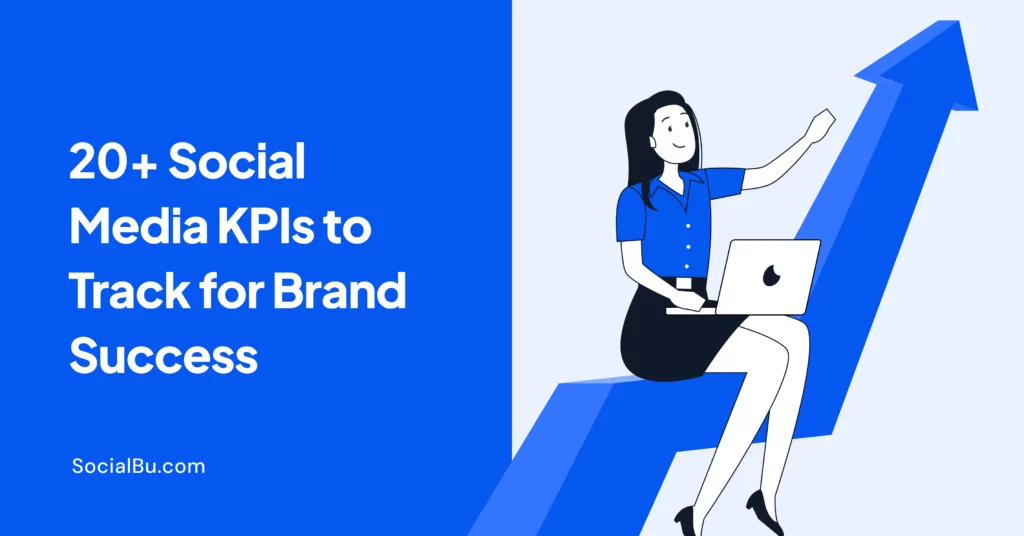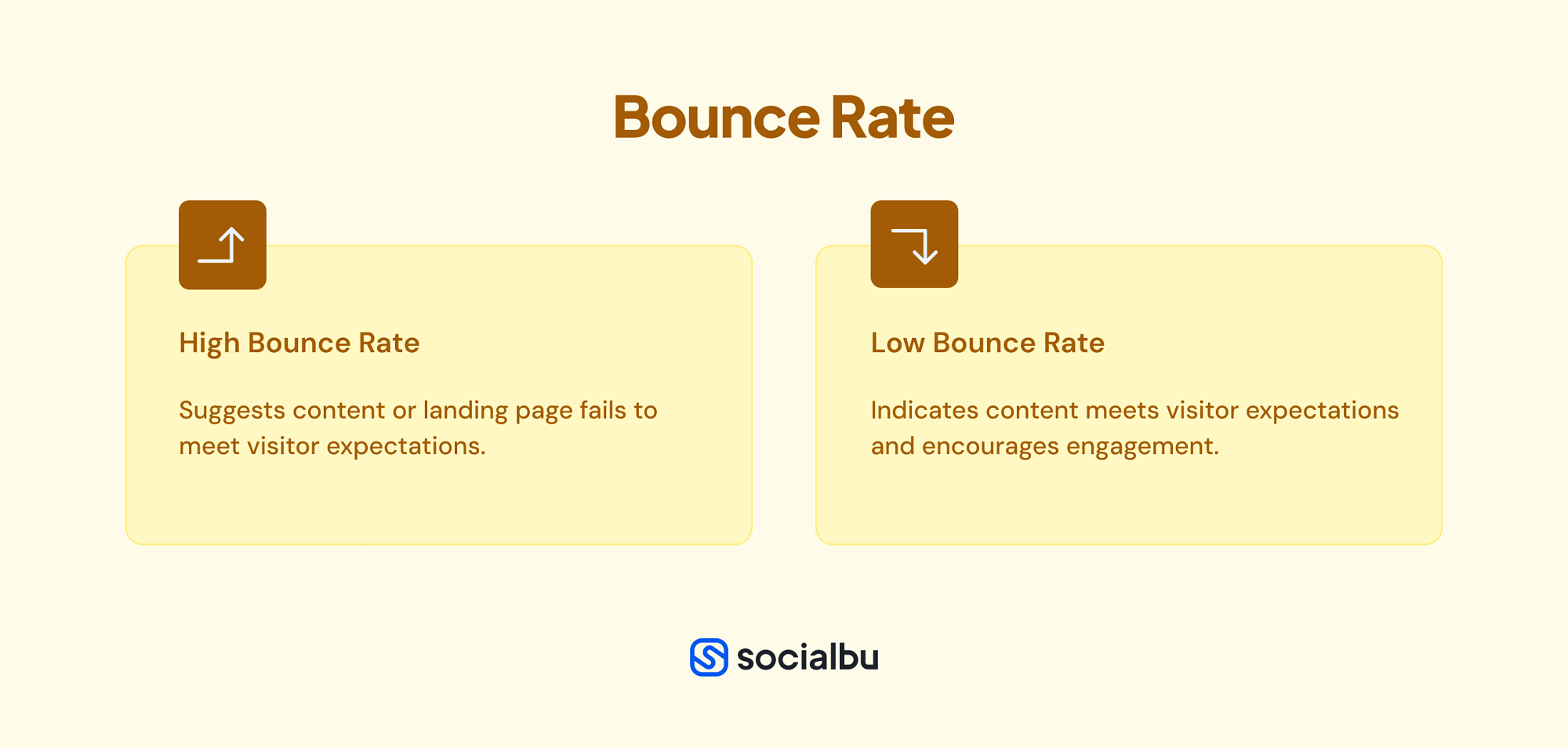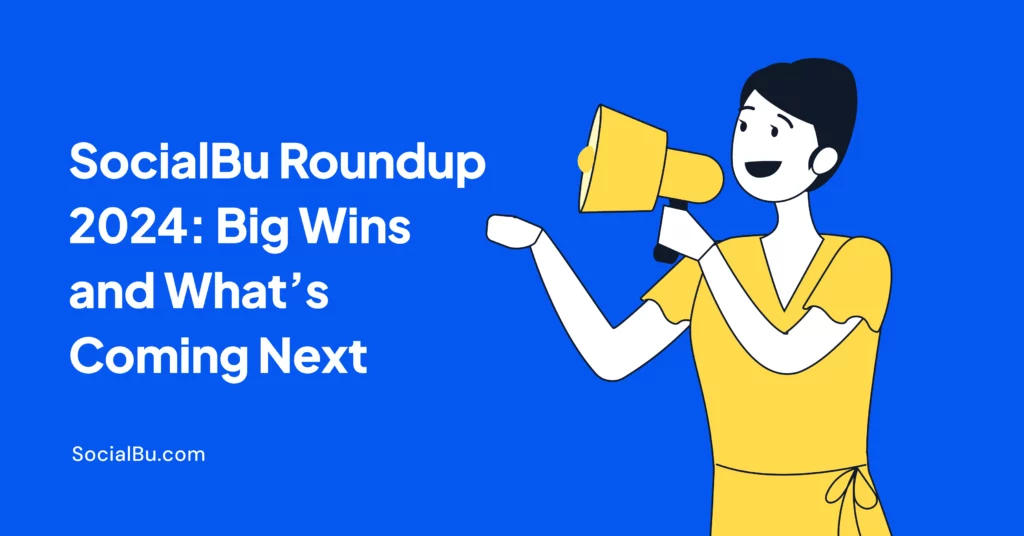20+ Social Media KPIs to Track for Brand Success
From TikTok to Instagram, global social media usage is rising by 5.17 billion people in 2025—more than half of the world’s population. While not all of these demographics use social media to communicate with businesses, many do. However, to understand how social media impacts the company particularly, you need to measure the correct social media KPIs.
The total spending on social media advertising is projected to hit $268 billion this year. This means that growing on Social media requires analyzing your online metrics from every perspective, from measuring reach to return on investment.
Let’s learn about some essential social media KPIs and how to set them.
What Are Social Media KPIs?
KPI stands for key performance indicators. It is a measurable value that brands use to monitor their progress toward key business objectives.
Social media KPIs are the numbers you use to determine if your strategy is effective and fulfilling your objectives. Metrics and KPIs alone do not provide the whole picture. It is a collection of numerous KPIs that will allow you to determine whether or not you are on track to meet your objectives.
Understanding which KPIs are important and how to track them enables you to develop a successful social media approach that will support your company’s success.
Why Track Social Media KPIs?
Social media KPIs help you understand your progress toward your goals and whether you need to make strategic changes. Tracking these metrics gives you valuable insights into your audience’s behavior, preferences, and engagement patterns.
This enables you to optimize your content strategy, allocate resources effectively, and measure the ROI of your campaigns.
Social Media KPIs to Track in 2025
Here are the 20+ social media KPIs to track in 2025.
1. Reach
Reach measures the number of people who view your people on social media. It is one of the most fundamental metrics for measuring social media KPIs, as it tells how visible your posts are. This allows you to work on business goals, such as enhancing brand visibility on social media platforms.
Moreover, social media reach varies across platforms. For instance, you might have a high reach on Instagram but a low one on X(Twitter). This can give you an idea of which platform your audience finds your content valuable and interesting.
2. Post Impressions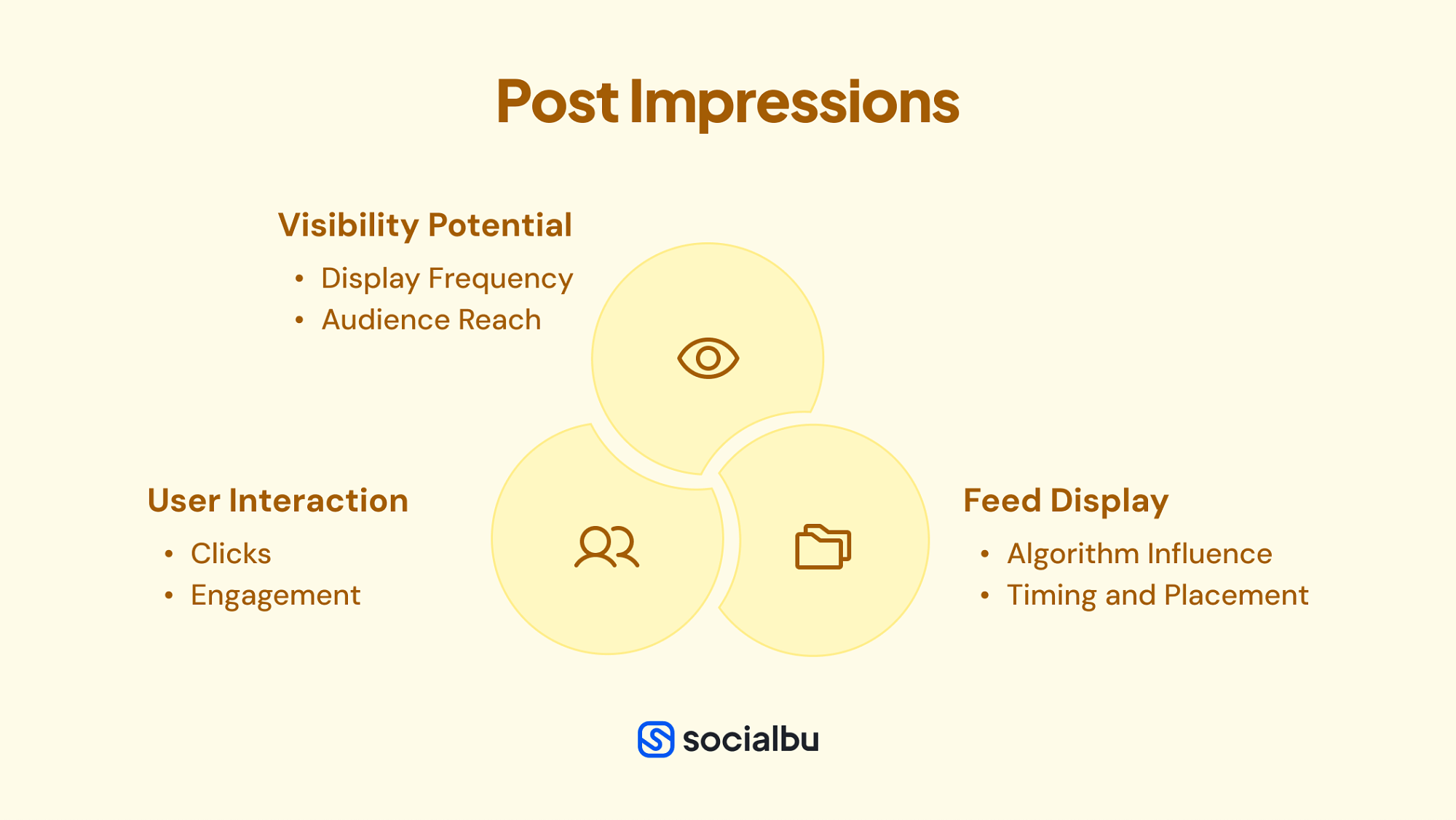
Another KPI for social media you should be aware of is post impressions. This represents the number of times your post was displayed to users on their feed, whether clicked or not. The social media KPI highlights insights into your posts’ visibility potential is a measure of possible visibility,
Many people confuse post impressions with reach. Impressions count the times your content shows up and whether or not it was clicked. Reach is the total number of unique users who see your posts,
3. Follower Count
Follower count indicates how many new people have followed you on social media over a given time frame. Using follower count KPI for social media shows how many people are interested in your content and brand.
Social media followers are loyal audiences who have opted to view your posts in their feeds and are known as followers. So, the more followers you have, the more people will view your posts in their feeds, increasing the chances of more interactions.
If you want more about getting followers on Instagram, read our Top Strategies to Grow Your Instagram Followers in 30 Days.
4 . Post Likes
Simple yet the most determining social media KPIs, post likes, are the number of times followers interact with a post by hitting the “Like” button. The social media KPI gives you an idea of how your content resonates with the audience. Whether your post strikes a chord or not
For instance, if a post gains more likes, it suggests that it resonated with the audience or provides
valuable information.
5. Bounce Rate
When someone clicks on your social network links, not all of them will read the entire post or make a purchase. Bounce rate is one of the key performance indicators in social media that tells the number of visitors that clicked the link on your social posts or bio but left without taking any action.
It is one of the few social KPIs you want to be low; a high bounce rate often indicates that the content or landing page did not meet your visitors’ expectations.
6. Comments
Comments indicate the number of times followers interact with your post. Unlike a simple like, a comment takes more effort and is typically considered a sign of greater interest.
It’s important to note that not all Social media comments can be positive. Negative or even abusive comments can significantly impact your brand image. Nevertheless, you can automate replies on social pages to make comments engaging social KPIs.
7. Post Shares
One of the best KPIs for social media is post shares, which serve as an interactive indicator for marketing efforts. It is an affirmation of your content’s value, relevancy, or pure entertainment that motivates the user to tap the ‘ share’ button.
When your content is shared, it is seen by your followers and extends to the network of the person who shared it. This makes “post shares” an important social KPI for any social media campaign, as it increases reach and boosts brand visibility.
8. Saves
The Saves indicates the number of people who bookmark your posts. This suggests that people like your content and find it helpful enough to save it to view later, which is a sign that you have given your audience something useful, interesting, or entertaining.
However, saves on social media such as Facebook and Instagram, unlike more visible interactions such as likes or comments, are often hidden from public view, making them a more subtle indicator of engagement.
9. Clicks
Clicks indicate how often users click the link on your post. This allows for better tracking of how individuals interact with posts outside the social platform. This social KPI measures how actively users interact with an ad or link. This directly measures user interest and serves as a baseline for engagement metrics in digital marketing initiatives.
10. Average Engagement Rate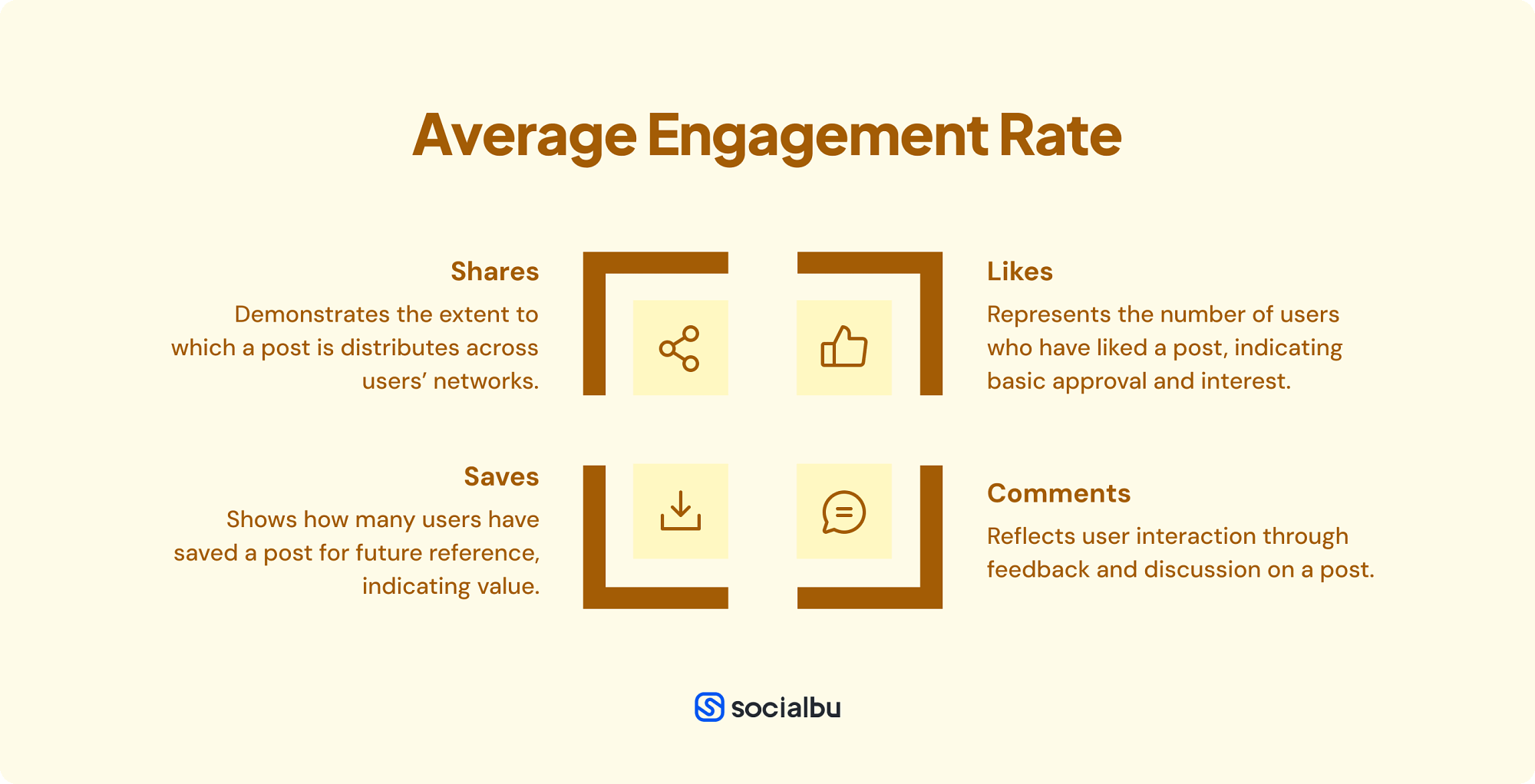
This indicator divides a post’s engagement—including likes, comments, saves, and shares—by the total number of followers on your social media account. It reveals how engaging your posts were on average.
For example, formulas divide interactions by followers to calculate engagement rates on Instagram. You can also use SocialBu to calculate your account’s overall engagement rate or analyze top-performing posts.
11. Profile Visits
When someone is first learning about your business, they will visit your website, sign up for your newsletter, and view your profile page. The profile visit count indicates how often your page has been seen in a certain period. This number is visible in native analytics and reminds you to update your profile with your most essential link destinations.
12. Lead Conversion Rate
Lead conversion rate refers to the percentage of users who take a desired action after interacting with your social media posts, such as clicking on the link on your post, making a purchase, signing up for a newsletter, or downloading an app. A high conversion rate shows that your content adds value to your sales funnel or promotes business growth. 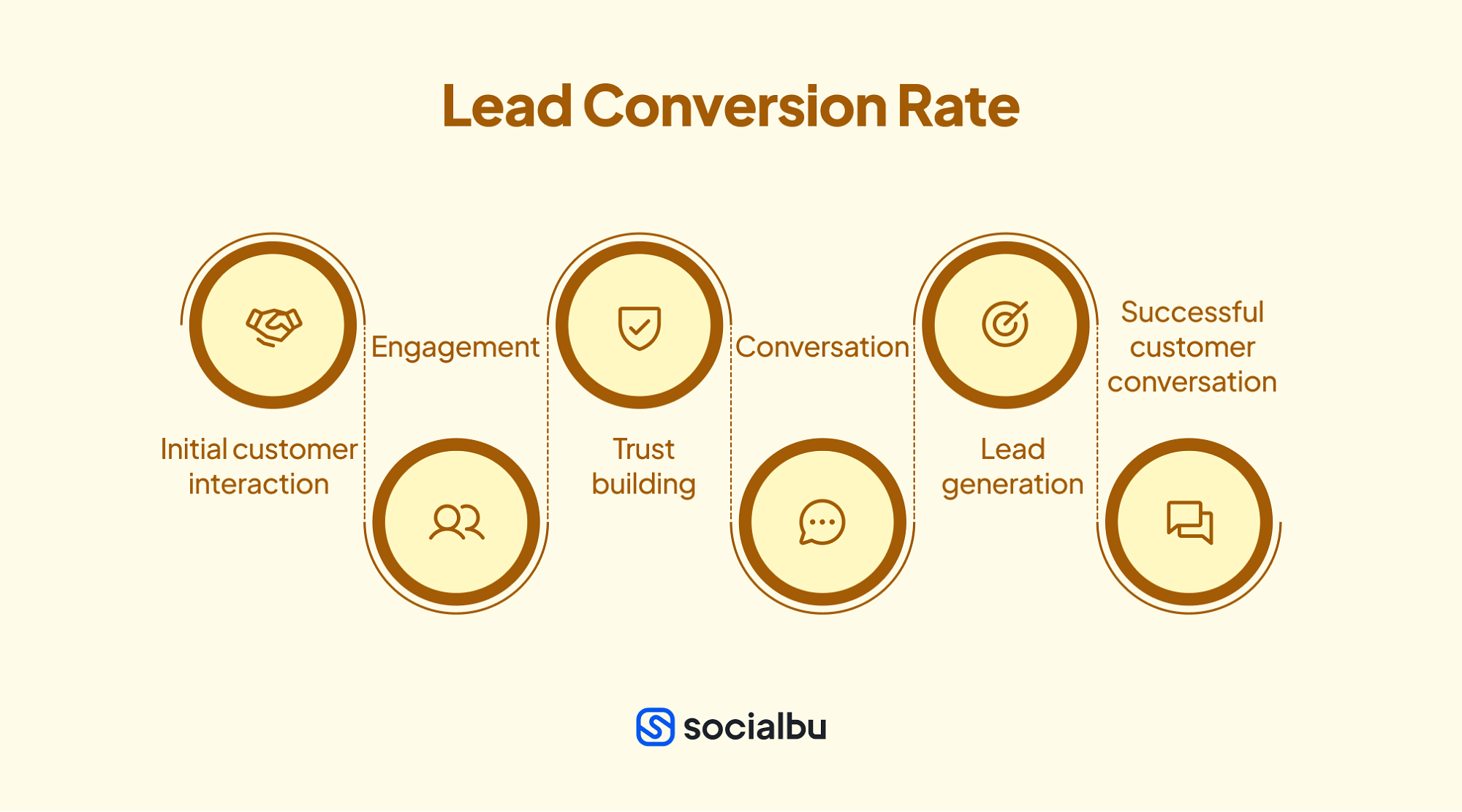
Additionally, you can calculate the conversion rate by taking the number of conversions and dividing that by the number of total ad interactions that can be tracked to a conversion during the same period.
13. Web Traffic
Web traffic lets you see how well your postings with links to your website are performing. It’s also an accurate measure of campaign performance. Web referral traffic is the number of times a user clicks from your social network account to one of your website pages. This information is easily accessible through Google Analytics or a website builder like WordPress or Wix.
14. Share of voice (SOV)
Share of voice (SOV) social media KPI indicates how much online visibility you have relative to competitors. This one isn’t readily available, unlike other analytics. Instead, you’ll need to select keywords, hashtags, or categories to focus on.
This comparison can be difficult without a social media reporting framework, especially when reviewing hashtags individually. That’s why a tool like SocialBu provides a hashtag and a keyword tracker to give a more practical overview of your SOV.
15. Lead Conversion Rate
The lead conversion rate indicates the success of your social media approach. Establishing trust with a customer takes time, but there are many ways to create leads using social media. Customers who see your product may not buy from you immediately but will be counted as customers later.
16. Customer Lifetime Value (CLV)
The customer lifetime value indicates how much money a customer spends with you over time. Following their initial purchase, your goal will be to attract repeat consumers who will make additional purchases. You’ll discover you have a high client lifetime value with the correct customer loyalty methods.
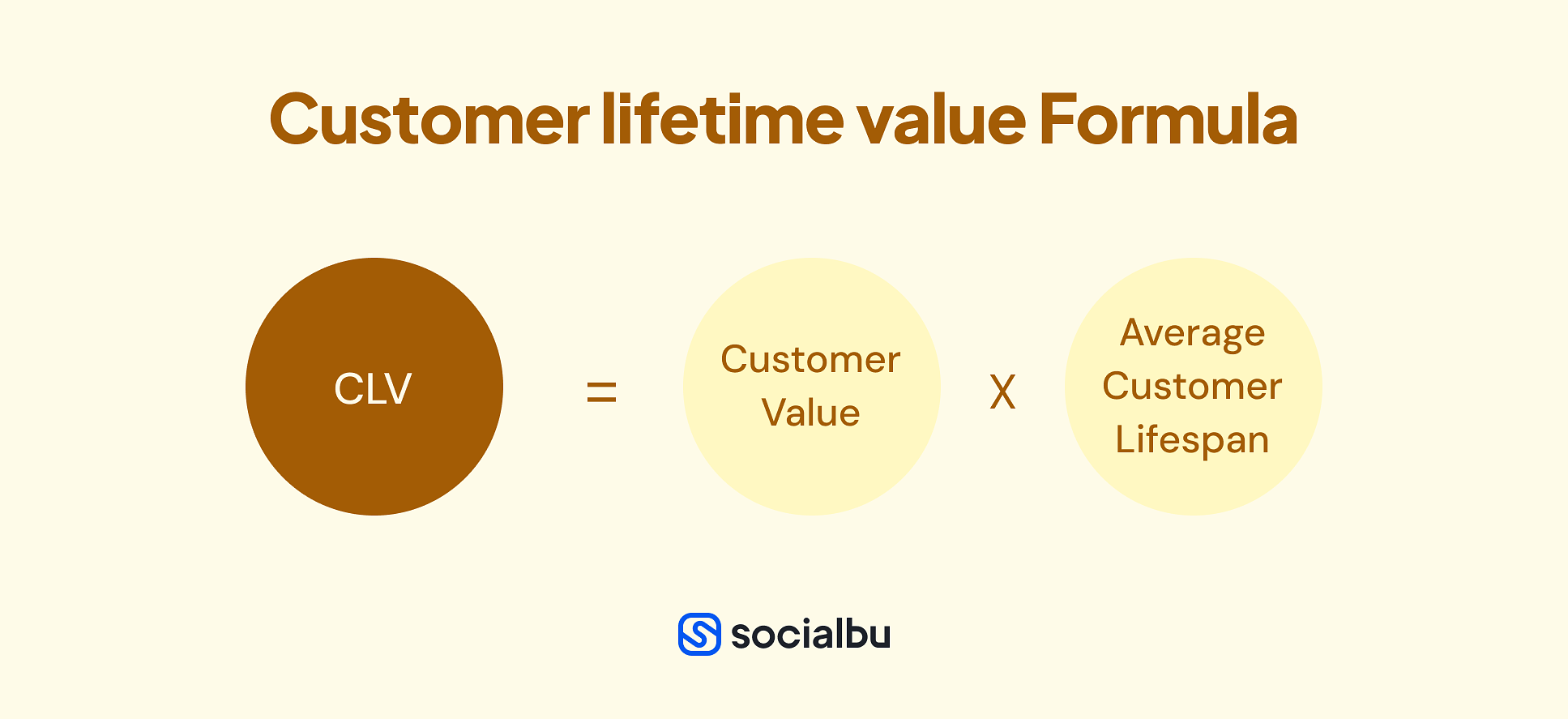
The formula for calculating customer lifetime value is CLV = customer value x average customer lifespan. Online CLV calculators can also assist with this process.
17. Average Response Time
This measures how long a customer care representative can respond to a customer following the initial contact, such as via a DM. You want to respond as quickly as possible. Many brands use a social media management tool, such as SocialBu, to automate replies so customers can get instant feedback on their queries.
18. First Contact Resolution Rate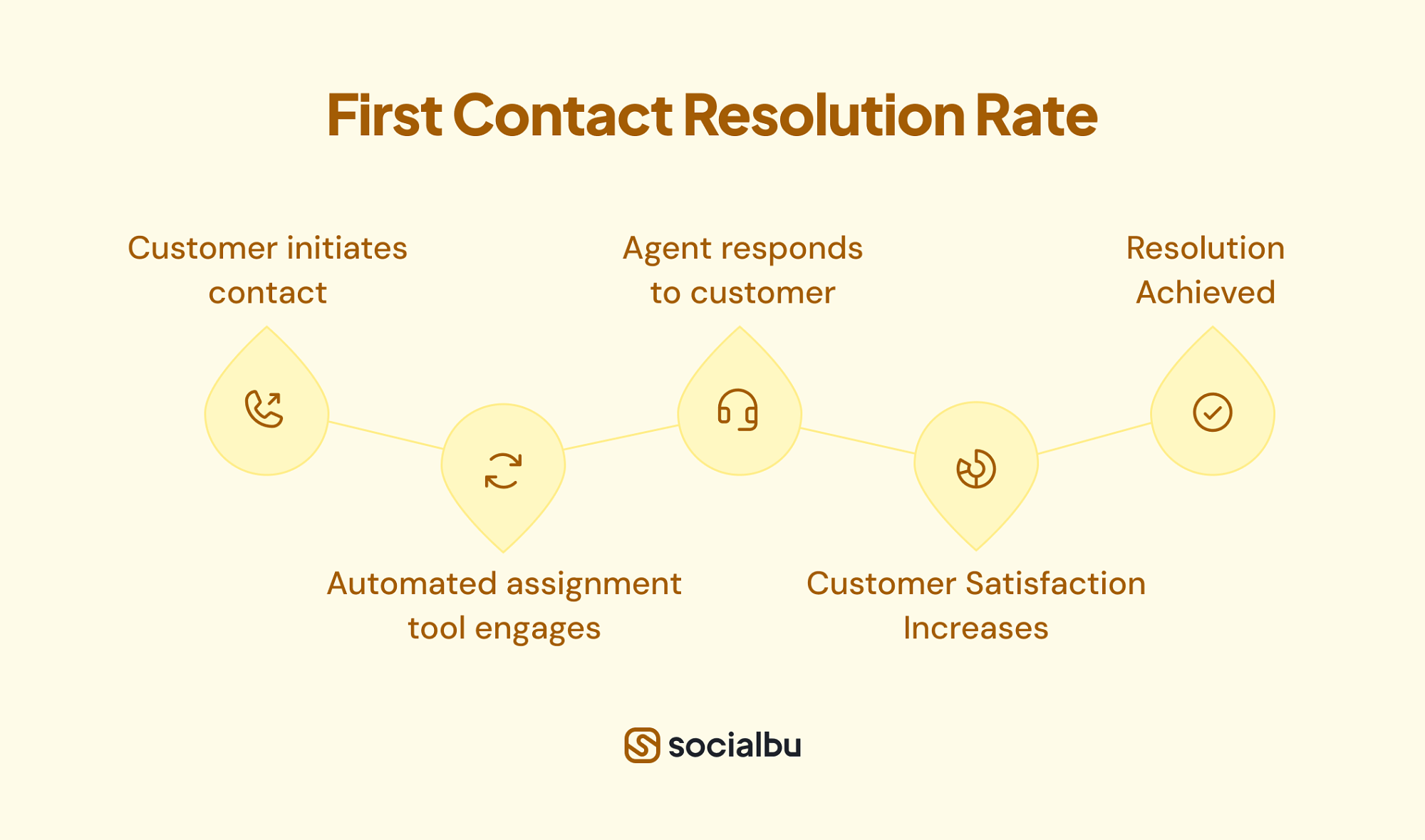
This metric tracks how frequently clients receive a resolution from the first agent they speak with. If you’re using an automated assignment tool, this determines how well it understands client demands and which team members can respond to them.
The social media KPI benefits brands, as customers become progressively frustrated each time they are transferred to another team member, especially if they must repeatedly explain their problem. Hence, a higher first contact rate for KPI will often result in higher customer satisfaction.
19. Audience Geographics
Audience geography involves analyzing your audience’s geographic location. Knowing where your audience lives allows you to optimize location-specific posts, improve posting times, and more efficiently target advertising.
For example, if a significant portion of your audience lives in the USA, you would center your content theme according to the American audience. In addition, to increase engagement metrics, the best time to post is when they are most active.
20. Net Promoter Score (NPS)
Your net promoter score measures your followers’ brand loyalty. After someone makes a purchase or interacts with your customer service team, ask them if they would recommend this product to a friend. 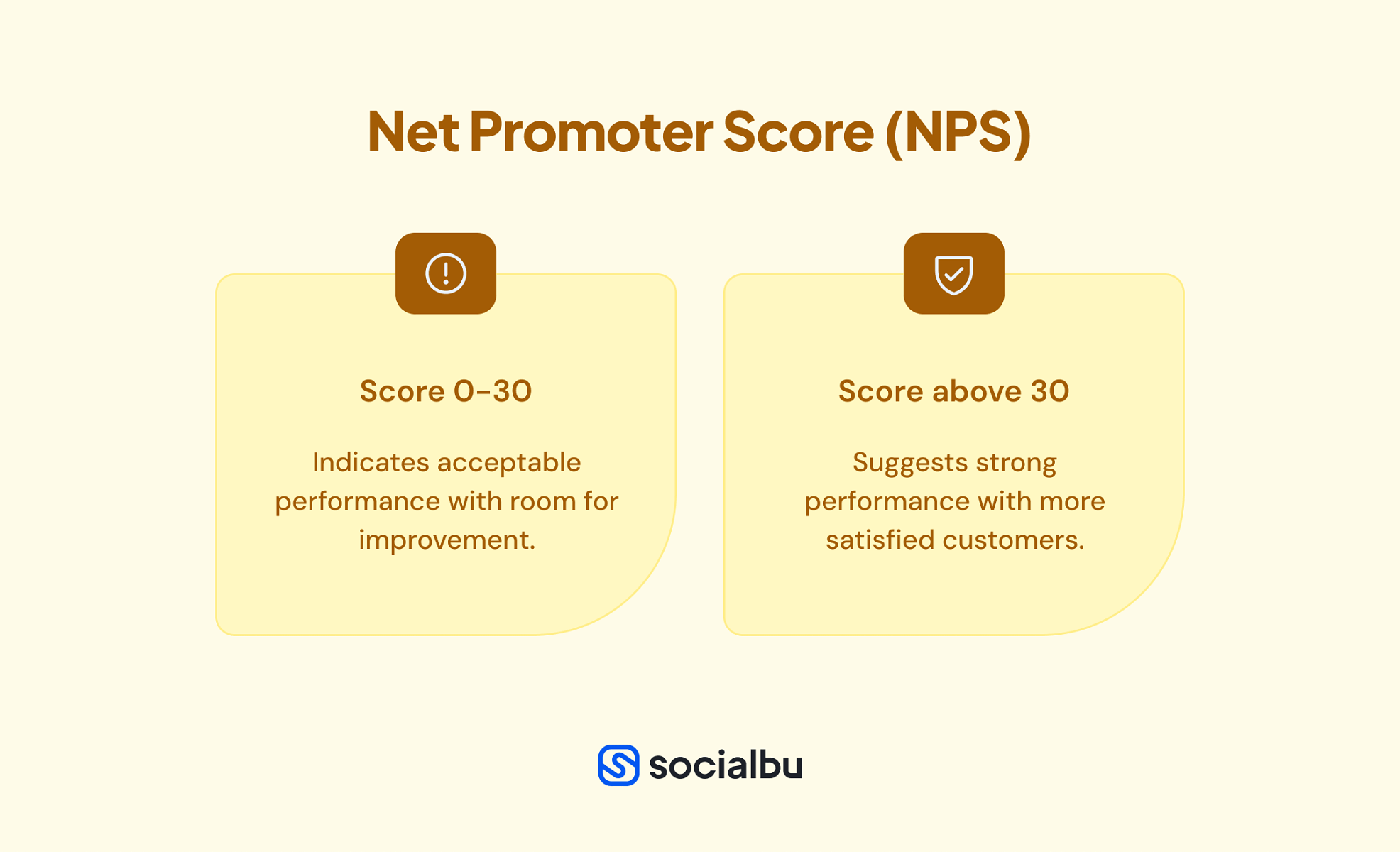
A score between 0 and 30 is acceptable, but there is still potential for improvement. If your NPS is over 30, your firm performs well and has considerably more satisfied customers than unhappy ones.
21. Virality Rate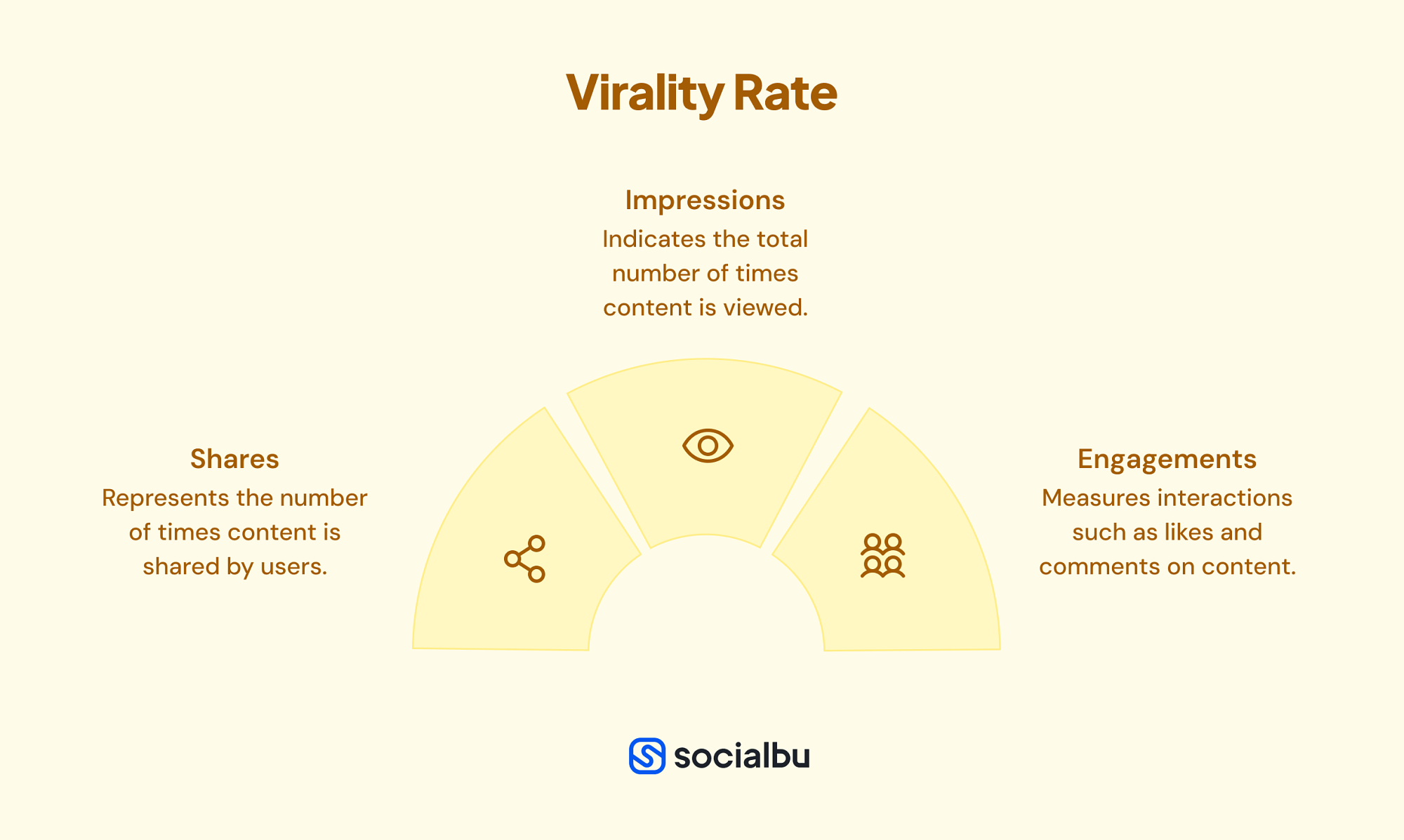
Viral engagement rate is a social media KPI that measures how quickly your content is shared on social media platforms by comparing the number of shares to the number of impressions. Vital marketing strategies include starting a trend, such as viral memes or a funny corporate joke shared by your social media content team.
It is a key component of your social media content strategy. Virality rate can be calculated as the ratio of shares or engagements to the total number of views or impressions expressed as a percentage
22. Return on Investment (ROI)
Lastly, one critical KPI for social media managers is ROI (Return on investment). This KPI helps you determine whether your social media campaigns are worth your investment. Understanding your social marketing strategy’s overall ROI will help you prepare to support future social media marketing.
How to Set the Right KPIs for Social Media
You know the essential social media KPIs, but should you track every single one? Let’s explore how to identify the best KPIs for your social media goals.
First things first, ask yourself your audience objectives. For example:
- Is the purpose of your social media advertising to raise brand awareness?
- Drive website traffic?
- Or to increase conversions and sales?
After choosing a plan, you must divide it into specific goals and social media KPIs.
In addition, you can track your competitors and compare your social media data, including profile impressions, reach, and likes, to those of your industry competitors.
Tracking social media KPIs with SocialBu
SocialBu Analytics makes it much easier to track your social media KPIs. It allows you to track the metrics of your social channels and organizes the KPIs into comprehensive, easy-to-understand reports.
Its analytics reports are configurable, allowing you to calculate and display your needs precisely. You can generate reports for particular social accounts or your brand’s social media platforms.
Bottom-Line
Monitoring social media KPIs is critical to any social media marketing strategy. Without tracking, you cannot determine whether you meet your company objectives.
Now that you understand how your KPIs will help you achieve your business’s objectives, choose one that will enable you to track your progress. For example, analyze Instagram reel views and track if your company is growth-oriented and you want to increase brand recognition on social media.
Use SocialBu to manage your social media reports from a single dashboard. Sign up for a free trial today.
FAQs
What metrics should you track to see how many unique users see your post?
To see how many unique users are seeing your post, track:
- Reach
- Impressions
- Follower Count
- Saves
How to track social media metrics?
To track social media metrics:
- Set clear goals
- Choose relevant metrics.
- Use analytics tools
- Track engagement metrics
- Monitor follower growth:
What is the 80/20 rule in social media marketing?
The 80/20 rule for social media marketing states that 80 percent of your social media posts should be valuable to your audience, while the other 20 percent should be promotional.
What is a good engagement rate on social media?
The average social media engagement rate depends on the platform, but it should be at least 2-5%.
How do you measure social media success?
To measure social media success, track engagement metrics (likes, comments, shares), reach and impressions, and conversions (website traffic, sales, leads). Moreover, Analyze your audience growth and demographics to understand your content’s resonance.
